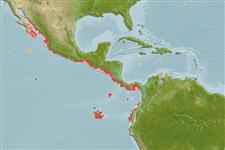Environment: milieu / climate zone / depth range / distribution range
Ecologie
marien; diepte ? - 70 m (Ref. 96339), usually ? - 50 m (Ref. 11035). Tropical; 28°N - 3°S, 112°W - 78°W (Ref. 54686)
Eastern Pacific: Santa Rosalita, Pacific coast of Baja, California, Mexico southward to Punta Sal and Punta Picos, Peru. (Earlier works probably combined data for Opisthonema bulleri and Opisthonema medirastre). Range is extended northwards to San Pedro, California (Ref. 35601). Rare on outer coast of Baja California Sur (Ref. 35601).
Grootte / Gewicht / Leeftijd
Maturity: Lm ? range ? - ? cm
Max length : 30.0 cm TL mannelijk / geslacht onbekend; (Ref. 55763); common length : 22.0 cm SL mannelijk / geslacht onbekend; (Ref. 9291); max. gepubliceerd gewicht: 261.36 g (Ref. 124487)
Dorsale stekels (totaal): 0; Dorsale zachte stralen (totaal): 13-21; Anale stekels 0; Anale zachte stralen: 12 - 23. The filamentous last dorsal fin ray distinguishes it from members of any other eastern Pacific clupeoid genus. Separated from eastern Pacific Opisthonema species by having 63 to 110 lower gill rakers in fishes over 14 cm standard length.
Usually occur near the surface of coastal and offshore waters, down to over bottom of continental shelf (Ref. 11035). Form dense schools. Apparently the most abundant of the eastern Pacific species of Opisthonema. Feed on phytoplankton (dinoflagellates and diatoms). Oviparous, with planktonic eggs and larvae (Ref. 35601). It is reduced to fish meal (Ref. 9291). Oil may be extracted (Ref. 9291). May be canned (Ref. 9291).
Whitehead, P.J.P., 1985. FAO Species Catalogue. Vol. 7. Clupeoid fishes of the world (suborder Clupeoidei). An annotated and illustrated catalogue of the herrings, sardines, pilchards, sprats, shads, anchovies and wolf-herrings. FAO Fish. Synop. 125(7/1):1-303. Rome: FAO. (Ref. 188)
Status op de Rode Lijst van het IUCN (Ref. 130435)
Gevaar voor de mens
Harmless
Gebruik door de mens
Visserij: van groot commercieel belang; aas: occasionally
Meer informatie
ReferentiesAquacultuurAquacultuurprofielKweeklijnenGeneticaElectrophoresesErfelijkheidZiektesVerwerkingNutrientsMassaconversie
Tools
Speciale rapporten
Download XML
Internetbronnen
Estimates based on models
Preferred temperature (Ref.
123201): 21.4 - 29, mean 27 °C (based on 86 cells).
Fylogenetische diversiteitsindex (Ref.
82804): PD
50 = 0.5312 [Uniqueness, from 0.5 = low to 2.0 = high].
Bayesian length-weight: a=0.00832 (0.00504 - 0.01373), b=3.02 (2.88 - 3.16), in cm total length, based on LWR estimates for this species & (Sub)family-body (Ref.
93245).
Trofisch niveau (Ref.
69278): 2.9 ±0.28 se; based on food items.
Weerstandsvermogen (Ref.
120179): Hoog, minimale populatieverdubbelingstijd minder dan 15 maanden (K=0.22-0.5).
Prior r = 0.90, 95% CL = 0.59 - 1.35, Based on 2 stock assessments.
Fishing Vulnerability (Ref.
59153): Low vulnerability (25 of 100).
Climate Vulnerability (Ref.
125649): Moderate vulnerability (37 of 100).
Nutrients (Ref.
124155): Calcium = 199 [90, 362] mg/100g; Iron = 1.94 [1.10, 3.34] mg/100g; Protein = 18.6 [17.5, 19.7] %; Omega3 = 0.37 [0.21, 0.67] g/100g; Selenium = 48.5 [23.7, 99.5] μg/100g; VitaminA = 26.8 [9.3, 78.7] μg/100g; Zinc = 1.41 [0.97, 2.09] mg/100g (wet weight);
